Operation (dictionary item)

For automation interface information about an Operation, see Operation (automation interface).
An operation is a function or transformation that can be applied to, or implemented by, the objects in a Class, Data Type or Interface. A Class, Data Type or Interface should have at least one Operation that performs a useful service to justify its existence. Operations:
• Describe the observable behavior of an object
• Apply to all members of the class
• Are defined once at the class level
• Are the visible interface to an internal method
• Can include optional parameters and/or return values.
Each operation must have a clearly defined signature consisting of the number and type of input arguments and return values.
Create an Operation in the following ways:
• Through the context menu of a Package or Model: right-click the item, and select > > > .
• Through the context menu of a Class, Data Type or Interface: right-click the item, and select > .
• Through the Operation button on the Class Diagram tab.
• Through the Items tab of a Class', Model's or Package's Property Pages.
An Operation message:
• Represents a signal between two objects
• Signals a request for a service
• Contains a signature which corresponds to the signature of an operation - a signature can include a name, optional parameters and optional return values.
On a Sequence Diagram, you can also add an instance of an Operation as a Reply Message. |
You can create an Operation in the following ways:
• Through the context menu of a Class, Data Type, Interface, Model or Package.
• Through the Operation button on the Class Diagram tab
• Through the Items tab of a Class', Data Type's, Interface's, Model's or Package's Property Pages.
In addition, you can also create an Operation by copying an existing Operation. Modeler copies the Operation's links, child items and child diagrams. For more information, see Copying items.
You can create a Return Type and Parameters for an Operation through its Signature. For more information, see Using an operation signature to specify properties and parameters. If an Operation's signature is greater than 200,000 characters, the Parameters' Default values are not included in the signature. |
When used on a Class Diagram, an Operation's notation is as follows:
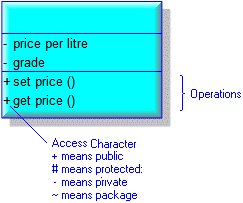
Abstract Operations are shown in italic text:
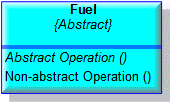
If the Operation has Constraints applied to it, you can show the Constraints through the View Options of the owning Class, Data Type or Interface – select the Show Constraints check box.
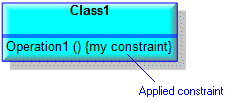
For information about the View Options available for this symbol, click one of the links below:
When used on a General Flow Diagram, you can link an Operation to an Action or Frame, and then show the Operation's Parameters, Exceptions and Return Type as pins on the diagram.
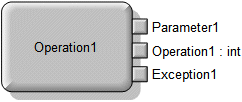
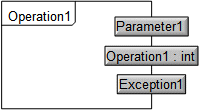
When used on a Concurrency Diagram, Communication Diagram, or Sequence Diagram, an Operation Message's notation is as follows:
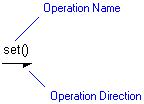
The following notation is used for the arrow:
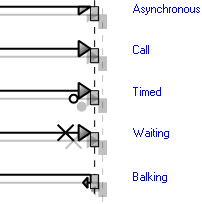
The following notation is used to show instance properties of an Operation Message on a Concurrency Diagram:
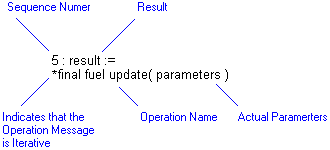
The following notation is used to show instance properties of an Operation Message on a Sequence Diagram:

In the Modeler panes, a short-cut symbol  on the Operation's icon indicates that the item is a stub.
on the Operation's icon indicates that the item is a stub.
 on the Operation's icon indicates that the item is a stub.
on the Operation's icon indicates that the item is a stub.If you select the UML\Operations folder in the Dictionary pane, the Contents pane displays the following information about each Operation in the model: Name, Parent, Access, Binding, Abstract, Immutable, Changed By or Changed On. |
You create overloaded operations by creating two or more Operations that have the same Name and the same parent. Although the Name of each overloaded Operation is the same, the signature of each overloaded Operation should be unique.
The following sections provide information about how an Operation is used in the model. For more information about a property, item, model part or diagram, click it.
Properties
In addition to the standard properties, an Operation has these properties:
• Abstract (Is Abstract through the automation interface)
• Binding
• Body
• Duration
• Language
• Parameter Order (Param Order through the automation interface)
• Return Type (Data Type)
• Visibility (Access through the automation interface)
An instance of an Operation (message) can have these properties:
• Actual Parameters (Name)
• Latency
• Result
Owned by
 Package —Note that on the Items tab of a Package's Property Pages, Operations are not listed in the All Package Items list.
Package —Note that on the Items tab of a Package's Property Pages, Operations are not listed in the All Package Items list.Owns
 Dependency —The Dependency is owned jointly by the Operation and the other associated item. The access permissions you have to a Dependency are determined by the access permissions of the dependent item.
Dependency —The Dependency is owned jointly by the Operation and the other associated item. The access permissions you have to a Dependency are determined by the access permissions of the dependent item.An Operation can own the following diagrams
Defined in these parts of the model
Used in:
Shown on these diagrams
Instances of an Operation can appear on these diagrams.
 State Diagram (as an activity)
State Diagram (as an activity)For information about how the View Options affect the presentation of Operations, click one of the links below:
Can be linked to these dictionary items
 Exception —The linked Exception specifies alternative courses of action if the Operation is not performed successfully. Exceptions contain a number of parameters, which are used to transmit or receive data from Operations.
Exception —The linked Exception specifies alternative courses of action if the Operation is not performed successfully. Exceptions contain a number of parameters, which are used to transmit or receive data from Operations. Event Action Block —The linked Event Action Block uses the Operation as a Call trigger. You can make this link by dragging an Operation to an Event Action Block.
Event Action Block —The linked Event Action Block uses the Operation as a Call trigger. You can make this link by dragging an Operation to an Event Action Block.Like most other items in a Model, an Operation can be linked to an Activity Partition, Comment, Frame Box, General Node, General Flow, General Flow Diagram Node, Constraint (applied), General Flow Diagram Flow or Swimlane. |
Can use these items as a data type
When an Operation uses an item as a data type, Modeler creates a special link between the Operation and the referenced item. You cannot navigate this link through the Links Editor. |
 Class
Class Data Type
Data Type Interface
Interface Model
Model Activity
Activity Comment
Comment Constraint
Constraint Parameter
Parameter Communication Diagram
Communication Diagram General Flow Diagram
General Flow Diagram Sequence Diagram
Sequence Diagram State Machine
State Machine Class Model
Class Model Class Diagram
Class Diagram Concurrency Diagram
Concurrency Diagram Variant Diagram
Variant Diagram Event
Event Stereotype
Stereotype Basic Type
Basic Type Signal
Signal Type Definition
Type Definition